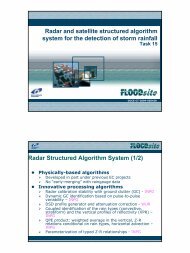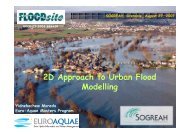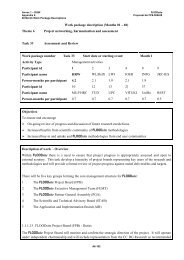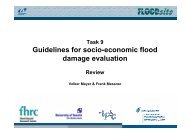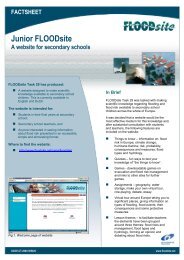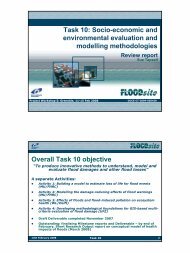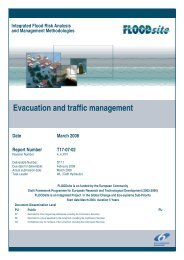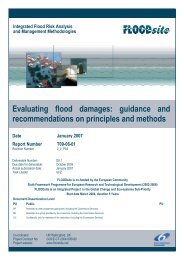Language of Risk - FLOODsite
Language of Risk - FLOODsite
Language of Risk - FLOODsite
You also want an ePaper? Increase the reach of your titles
YUMPU automatically turns print PDFs into web optimized ePapers that Google loves.
<strong>FLOODsite</strong> <strong>Language</strong> <strong>of</strong> <strong>Risk</strong> 2 nd Ed.<br />
Contract No:GOCE-CT-2004-505420<br />
The amount <strong>of</strong> potential damage caused to a system by a particular-related event or hazard.<br />
Jones and Boer (2003)<br />
The degree to which a system is susceptible to, or unable to cope with, adverse effects <strong>of</strong> climate<br />
change, including climate vulnerability and extremes. Vulnerability is a function <strong>of</strong> the character,<br />
magnitude, and rate <strong>of</strong> climate variation to which a system is exposed, its sensitivity, and its adaptive<br />
capacity.<br />
IPCC (2001) Climate change 2001: Impacts, Adaptation and Vulnerability, Summary for<br />
Policymakers, WMO.<br />
Recommendation: Characteristic <strong>of</strong> a system that describes its potential to be harmed. This can be<br />
considered as a combination <strong>of</strong> susceptibility and value.<br />
Rationale: There are a number <strong>of</strong> conflicting definitions for vulnerability, the overriding theme<br />
however, relates to the system characteristics (people, property etc.) that have the potential to be<br />
harmed (by a hazard). The “multiplication” <strong>of</strong> susceptibility by value proposed by Klijn (2004) is too<br />
prescriptive, whereas the proposed definition as a “combination” allows flexibility in the descriptions<br />
<strong>of</strong> susceptibility and <strong>of</strong> value in non-monetary terms.<br />
4.3 <strong>Risk</strong><br />
Hazard*(exposure)*vulnerability<br />
Probability*(exposure)*consequence<br />
Klijn (2004)<br />
Combination <strong>of</strong> the probability <strong>of</strong> occurrence <strong>of</strong> harm and the severity <strong>of</strong> that harm<br />
ISO/EC (1999)<br />
The probability <strong>of</strong> harmful consequences, or expected losses (deaths, injuries, property, livelihoods,<br />
economic activity disrupted or environment damaged) resulting from interactions between natural or<br />
human-induced hazards and vulnerable conditions<br />
ISO/EC (2002)<br />
Impact <strong>of</strong> hazard * Elements at risk *Vulnerability <strong>of</strong> elements at risk<br />
(Blong, 1996, citing UNESCO)<br />
‘<strong>Risk</strong>’ is the probability <strong>of</strong> a loss, and this depends on three elements, hazard, vulnerability and<br />
exposure”. If any <strong>of</strong> these three elements in risk increases or decreases, then risk increases or<br />
decreases respectively.<br />
(Crichton, 1999)<br />
<strong>Risk</strong> = Hazard *Vulnerability ´Value (<strong>of</strong> the threatened area) ¸ Preparedness<br />
(De La Cruz-Reyna, 1996)<br />
“<strong>Risk</strong> (i.e. ‘total risk’) means the expected number <strong>of</strong> lives lost, persons injured, damage to property<br />
and disruption <strong>of</strong> economic activity due to a particular natural phenomenon, and consequently the<br />
product <strong>of</strong> specific risk and elements at risk.<br />
Total risk can be expressed in pseudo-mathematical form as: <strong>Risk</strong>(total) = Hazard * Elements at <strong>Risk</strong><br />
*Vulnerability<br />
T32_04_01_ <strong>FLOODsite</strong>_<strong>Language</strong>_<strong>of</strong>_<strong>Risk</strong>_D32_2_v5_2_P1 30 April 2009<br />
14



